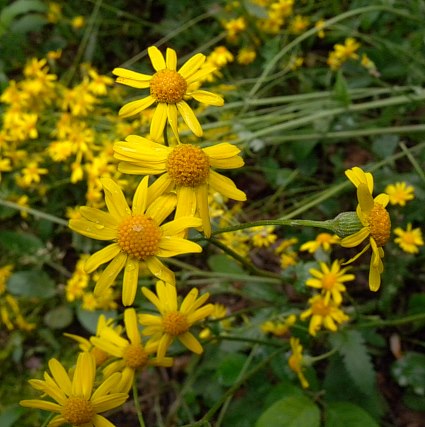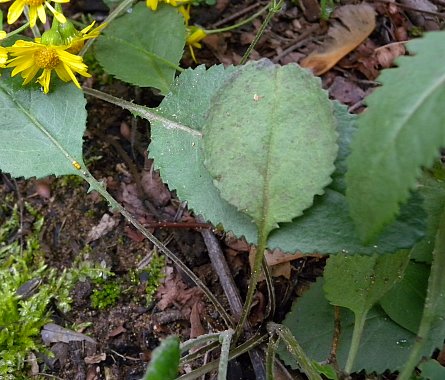
Cultivation: The preference is moist to dry-mesic conditions, full to partial sunlight, and soil containing loam, sand, or rocky material.
Range & Habitat: The native Spoon-Leaved Ragwort is found in east-central Illinois and scattered areas elsewhere within the state, where it is rare (see Distribution Map). Illinois lies along the western range-limit for this species; it is more common further to the east. Habitats include rocky upland woodlands, edges of bluffs, limestone glades, loamy savannas, and sandy savannas. Occasional disturbance is beneficial if it reduces competition from woody vegetation.
Faunal Associations: The nectar and pollen of the flowerheads attract cuckoo bees (Nomada spp.), Halictid bees (Augochlorella spp., Halictus spp., Lasioglossum spp.), Andrenid bees (Andrena spp.), Syrphid flies, Tachinid flies, and miscellaneous beetles. One bee species, Andrena gardineri, is a specialist pollinator (oligolege) of Packera spp. (ragworts). Another insect, Neacoryphus bicrucis (White-Crossed Seed Bug), feeds on the seeds of these plants, while the caterpillars of an uncommon butterfly, Calephelis borealis (Northern Metalmark), feed on the foliage of Spoon-Leaved Ragwort in particular. The foliage of this and other ragworts is toxic to many mammalian herbivores, although sheep are more tolerant of it (Georgia, 1913).

Photographic Location: A wildflower garden at Kitty Todd Nature Preserve in NW Ohio.
Comments: The different species of ragwort are distinguished from each other by the shape of their basal leaves and hairiness of individual plants. Spoon-Leaved Ragwort (Packera obovata) resembles Golden Ragwort (Packera aurea), except its leaves are not indented (cordate) where the petioles join the blades. It is also more likely to have narrowly winged petioles than the latter species. Spoon-Leaved Ragwort also resembles Prairie Ragwort (Packera plattensis), except it lacks the abundant cobwebby and mealy hairs of the latter during the blooming period. Spoon-Leaved Ragwort often has some cobwebby hairs toward the base of its stems and along its petioles, but not to the same extent as Prairie Ragwort. In addition, plants of the latter species are usually smaller in size. A scientific synonym of Spoon-leaved Ragwort is Senecio obovatus.